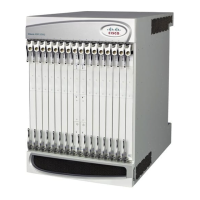HRPD Serving Gateway Overview
▀ Features and Functionality - Base Software
▄ Cisco ASR 5000 Series Product Overview
PPP VSNCP
VSNCP offers streamlined PPP signaling with fewer messages to reduce connection set-up latency for VoIP services
(VORA). VSNCP also includes PDN connection request messages for signaling EPC attachments to external networks.
Vendor Specific Network Control Protocol (VSNCP) provides a PPP vendor protocol in accordance with IETF RFC
3772 that is designed for PDN establishment and is used to encapsulate user datagrams sent over the main A10'
connection between the UE and HSGW. The UE uses the VSNCP signaling to request access to a PDN from the
HSGW. It encodes one or more PDN-ID's to create multiple VSNCP instances within a PPP connection. Additionally,
all PDN connection requests include the requested Access Point Name (APN), PDN Type (IPv4, IPv6 or IPv4/v6) and
the PDN address. The UE can also include the Protocol Configuration Options (PCO) in the VSNCP signaling and the
HSGW can encode this attribute with information such as primary/secondary DNS server or P-CSCF addresses in the
Configuration Acknowledgement response message.
Congestion Control
The congestion control feature allows you to set policies and thresholds and specify how the system reacts when faced
with a heavy load condition.
Congestion control monitors the system for conditions that could potentially degrade performance when the system is
under heavy load. Typically, these conditions are temporary (for example, high CPU or memory utilization) and are
quickly resolved. However, continuous or large numbers of these conditions within a specific time interval may have an
impact the system‘s ability to service subscriber sessions. Congestion control helps identify such conditions and invokes
policies for addressing the situation.
Congestion control operation is based on configuring the following:
Congestion Condition Thresholds: Thresholds dictate the conditions for which congestion control is enabled
and establishes limits for defining the state of the system (congested or clear). These thresholds function in a
way similar to operation thresholds that are configured for the system as described in the Thresholding
Configuration Guide. The primary difference is that when congestion thresholds are reached, a service
congestion policy and an SNMP trap, starCongestion, are generated.
A threshold tolerance dictates the percentage under the configured threshold that must be reached in order for
the condition to be cleared. An SNMP trap, starCongestionClear, is then triggered.
Port Utilization Thresholds: If you set a port utilization threshold, when the average utilization of all
ports in the system reaches the specified threshold, congestion control is enabled.
Port-specific Thresholds: If you set port-specific thresholds, when any individual port-specific
threshold is reached, congestion control is enabled system-wide.
Service Congestion Policies: Congestion policies are configurable for each service. These policies dictate how
services respond when the system detects that a congestion condition threshold has been crossed.
Important: For more information on congestion control, refer to the Congestion Control chapter in this guide.

